Sneakers are not tennis shoes, and tennis shoes are not sneakers. Do you have a hard time understanding the difference between sneakers and tennis shoes? Our team explains it to you.
While words are often used interchangeably, their definitions differ, despite their similar meanings. It is undeniable that the debate between tennis shoes and sneakers is such an example.
It might surprise you to learn that these two words have two distinct meanings, even though people often mistake them as synonyms (and you might be one of them!). You’re not alone if you don’t know the difference between these two words; however, I’ve got the real definitions below!
It seems that a lot of you are curious about the difference between sneakers and tennis shoes when to wear them, and more! I’ll let you in on some useful information, too! Read on to find out all the details.
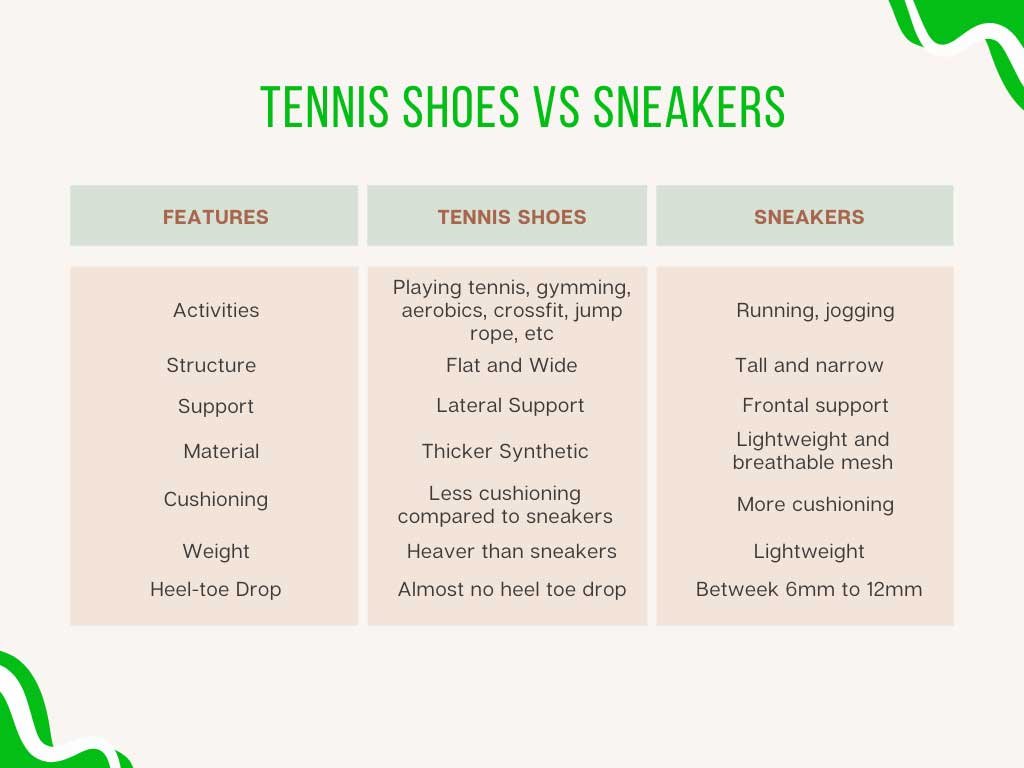
What are Sneakers?
In 1892, a US Rubber company introduced sneakers, which quickly became one of the most popular footwear types. In addition to walking, running, and playing different sports such as basketball, these shoes have rubber soles that make them very comfortable.
Since the rubber soles make little noise on most surfaces, the sneaker’s name comes from the fact that it can be worn almost anywhere.
Taking sneakers as an example, see them as a tree with a variety of branches, such as a slip-on shoe, a high-top shoe, and so on.
The term “sneakers” is an umbrella term for many different types of shoes. Tennis shoes can also be included in this tree as a separate branch.
For the upper part of sneakers, rubber, canvas, and synthetic materials are typically used, as well as rubber soles. In general, people think of gym shoes as athletic shoes that are used in the gym. However, these shoes aren’t made to serve a specific purpose.
The majority of sneakers aren’t designed for tennis but are more suited to casual use and styling. As long as you wear sneakers when playing tennis, nobody will stop you.
How to Choose a Sneaker
The price is not the only factor you should consider when choosing a good sneaker. Your decision should be based on the following factors.
Shoe Space
- Ensure that the sneaker is wide and deep enough to provide comfort.
- Toe room is also important. The foot extends one centimeter in each direction during walking.
- Your longest toe length should determine which sneaker has ample toe room.
The heel of the Shoe
- The heel of the shoe cannot exceed 2.5 cm. Walking without this will lead to ankle and heel sprains.
Stability
- As a walking shoe, the shoe should provide stability and support.
- You should be able to move the heel vertically or horizontally in the heel cup.
Adjustable Strap
- A Velcro or laces strap should be adjustable for the individual.
Cost, Style, and Color
- Fashion trends are always changing, so choosing a sneaker that suits your budget, aesthetics, and color profile is a good idea.
- When a sneaker is bought based on current fashion trends, the user could overcapitalize.
What are Tennis Shoes?
A tennis shoe is a type of sneaker made specifically for hitting tennis balls on tennis courts, although it can also be used for playing croquet, going bicycling, or simply just for casual wear like any other sneaker. Originally called Plimsoll shoes, they date back to the mid to late 1800s.
The tennis shoe is considered a separate branch of the sneakers family tree, but the Converse is not true, as tennis shoes are not sneakers. Tennis shoes cannot be sneakers.
Designed to protect your legs and feet from injury while you play tennis, they’re made of materials that absorb shock when you play. In tennis shoes, there is less padding to allow for quick movements on the court and plenty of lateral support.
In addition to being durable, these shoes resist wear and tear thanks to polyurethane soles, which brace the impact of your feet hitting the ground.
As tennis shoes are primarily designed to protect ankles and make the player comfortable during play, they are also slimmer. Last but not least, tennis shoes are divided into subcategories. Tennis shoes are often divided according to the type of court they are designed for.
You may also check Best Clay Court Tennis Shoes
How to Choose a Tennis Shoe
To begin playing tennis, you must determine the court. It is important to wear shoes with adequate traction when playing on a hard court. A shoe with patterns on the outside will be required if you are playing on a clay court.
There will be nubs on the bottom of the grass-court shoes to prevent them from slipping.
It is possible for your feet to become hot and sweaty when running around the tennis court. In summer, it is therefore recommended that you choose a tennis shoe that is lightweight, breathable, and well-ventilated.
In terms of men’s and women’s models, the Bigshot Light 2.5 from K.Swiss is the best-selling model
There is no restriction to the lateral movement of the player due to the thin padding on the inside of the shoe.
Difference Between Sneakers and Tennis Shoes
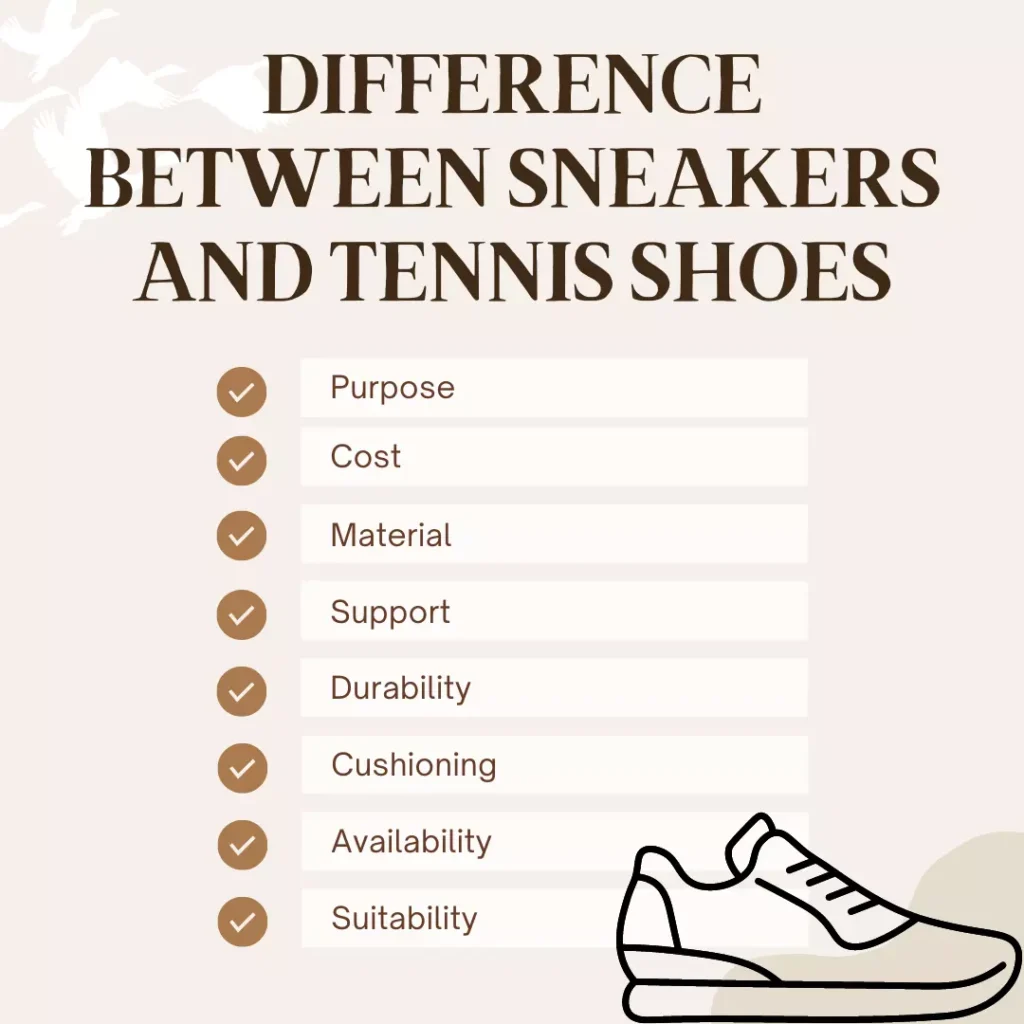
Essentially, the difference between sneakers and tennis shoes lies in how they are designed. The sole purpose of sneakers is to walk and run, while the purpose of tennis shoes is mainly to play tennis.
1- Purpose
Sneakers are primarily designed to cushion the foot during running and walking. Sneakers are based on the idea that you move forward when you run, for example. During running, you rarely move laterally, so this type of shoe provides support and comfort for heel-to-toe movements.
As opposed to that, tennis shoes are designed primarily for use on tennis courts, and while they can be used for walking as well, they aren’t primarily designed for that purpose.
Tennis shoes are designed to accommodate lateral, side-to-side movements that are common in tennis. The purpose of these shoes is the exact opposite of what sneaker shoes do, although they belong to the same shoe family.
2. Cost
During the production process of tennis shoes, models, and brands, technology that is “innovative” is included.
In cheap sneakers, the rubber soles are not as durable, the air in the soles is almost nonexistent, and the stitching isn’t as intricate.
Sneakers with unique comfort additions or technology are often priced more expensively.
Generally, tennis shoes cost more than sneakers because they have to meet certain court requirements.
Limited models or specialty sneakers are advertised at the top of the spectrum [the high-end side].
3- Material
A sneaker’s material is also lighter than a tennis shoe’s. They differ in weight primarily because of how they are used. If runners have extra weight on their feet, they would have a harder time running.
Tennis shoes are still lightweight, but they prioritize stability over any other aspect, not sacrificing any to reduce weight. Tennis players also benefit from heavier tennis shoes because they can exert more pressure on their legs if they have to play with one leg. A runner who uses both feet simultaneously is not required to do this.
Meanwhile, tennis players are often forced to shift their weight abruptly on the court as they maneuver around.
Tennis shoes are also made of shock-absorbing fabric while playing to absorb the shock. Typically, we see this material in tennis shoes and not any other type of sneaker because it absorbs shock and makes forward movement more difficult.
You may enjoy reading Shortest Women’s Tennis Players
4- Support
Considering you’ll be making lots of sudden movements from side to side, tennis shoes are very supportive of your ankles.
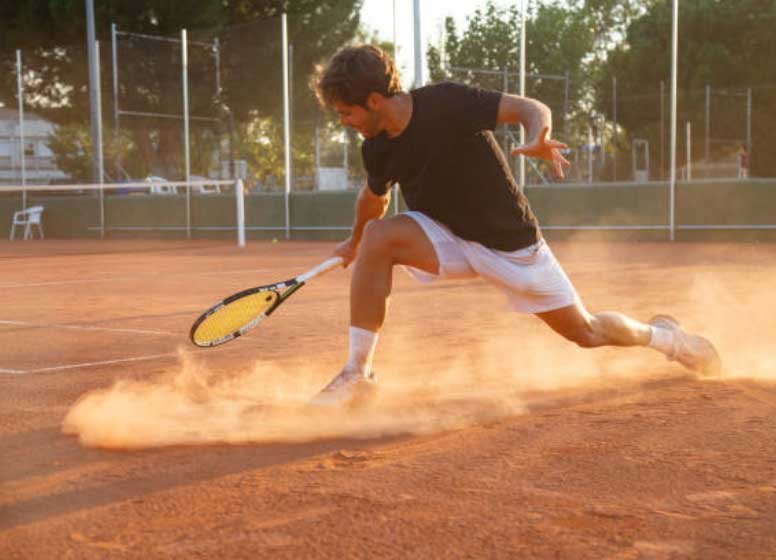
You would more likely sprain your ankle wearing a normal shoe, like a sneaker.
The collars of tennis shoes can be padded, the mids can be reinforced, and the midfoot can have a supportive shank, helping your ankle remain supported, especially with tight laces.
High-top shoes can also help support your stability, but they might restrict your movements and make them slower. Due to your ankles being held in place extra tightly, you experience this slowdown.
Even if you have had an injury recently or are concerned about the health of your ankle, you should still try them out. As long as you don’t slip in the shoes, tennis shoes offer more of these features than sneakers. Since running is less likely to cause your ankle to sprain when you run forward, they offer less in this regard.
5- Durability
Durability is one of the most important factors to consider when purchasing shoes. Tennis shoes are generally more durable than regular sneakers, though high-quality sneakers can be quite durable as well. The weight of tennis shoes makes them more durable than sneakers, as we previously discussed.
Though there are certainly lighter tennis shoes available, they won’t last as long as heavier shoes, and they will likely wear out more quickly.
Clay courts aren’t quite as tough on the outsole, so lightweight shoes are more appropriate on clay courts than hard courts since hard courts are harsher on your shoes.
6- Cushioning
Compared to sneakers, tennis shoes have less cushioning. Tennis shoes provide stability and flexibility rather than general comfort, so they have less cushioning than sneakers.
While playing tennis, foam or EVA cushioning helps absorb the shock experienced by the steps taken by the player.
You may enjoy reading Best Tennis Shoes For Hard Courts
7- Availability
There is a greater variety of sneakers available than tennis shoes. The sneakers we wear on casual outings, such as jogging, gym, and casual outings, serve both functional and fashion purposes.
They are available in almost all shoe stores worldwide since they are an “all-around” shoe type.
The result is that you will have no problem finding sneakers that fit your style. Tennis shoes, on the other hand, are shoes that are designed for a specific purpose. During a tennis match, they are designed to help tennis players feel comfortable. I am surprised that any pair of tennis shoes could be found in a small shoe store since they are so specific in their purpose.
If you live in a place with a limited variety of athletic shoe stores, you’ll have to search for them there. The best place to buy tennis shoes in this case may be online shoe stores!
8. Suitability
As much as sneakers are for athletic purposes, they are also for style. Sporting goods stores – both online and in-person – offer an almost endless selection of products. The majority of on-foot equipment is meant for running, basketball, and many other sports, including soccer, skateboarding, volleyball, and many others.
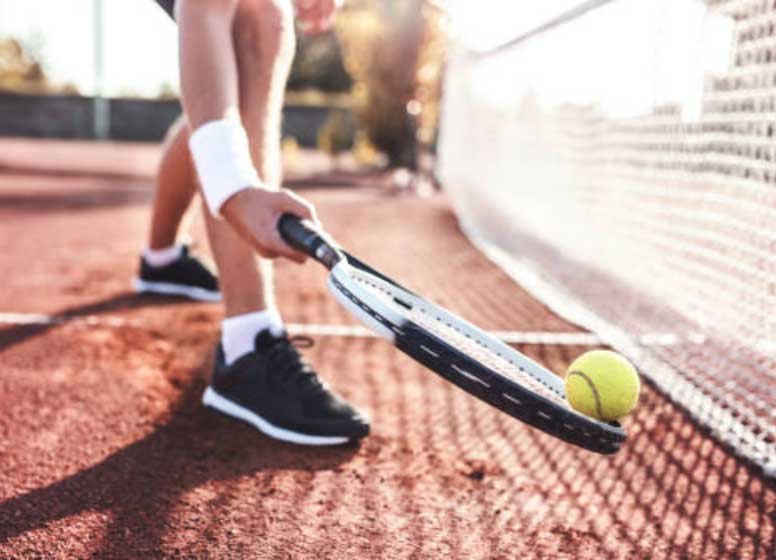
There are also numerous websites where you can customize your own pair of sneakers by choosing from a variety of colors, patterns, laces, stitching, and soles. They were not designed specifically for a sports activity, but are athletic shoes.
In comparison to tennis shoes, sneakers offer better comfort in comparison to them. Tennis shoes also offer certain technical features like non-scuffing soles, lateral support, and shock-absorbing materials that you can’t get from sneakers.
The overall concept of sneakers is that they are stylish everyday shoes that can be worn with jeans like any other.
Conversely, tennis shoes were designed to play tennis. Technically, these shoes are distinguished by their support type, weight, flexibility, breathability, and other characteristics.
They help players perform better on the court, enhancing their ability to move efficiently and change directions cleanly. On clay, hard, or grass courts, even the soles are designed for traction.
A tennis shoe is designed to accommodate rapid starts and stops on flat surfaces, such as a tennis court, as well as jerky lateral maneuvers. During quick, sharp lateral movements, tennis shoes provide a stable, flat bottom that prevents ankles from rolling.
In traditional white tennis shoes, rubber soles are used to prevent skid marks on the court surface, while nylon or leather uppers are used.
There is no real need for longevity on a grass or clay court since they are far more forgiving. There is a pattern on the sole that is designed for specific court surfaces.
The Herringbone pattern works well on hard surfaces but grass surfaces tend to be slippery, so a nabbed or dimpled sole would be a better choice.
Shoes with adequate shock absorption and cushioning should be worn by athletes who practice or compete on hard surfaces.
History of Tennis Shoes vs Sneakers
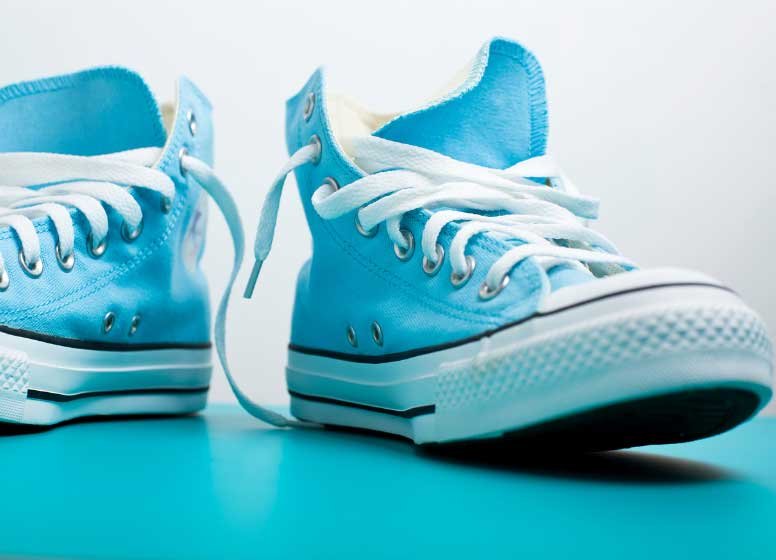
The first active shoes appeared much later after humans had been wearing them for several centuries. Throughout history, tennis shoes and sneakers have been a part of our lives.
- The mid-1800s: Travelers and leisure class wear canvas shoes with rubber outsoles (aka plimsolls).
- The late 1800s: Rubber soles are thickened and engraved treads are added to plimsolls to accommodate tennis players. There are also shoes developed for badminton and croquet.
- The 1890s: Running shoes are introduced to the world.
- In the early 20th century: Running shoes were ordered for the Summer Olympics throughout Europe.
- The 1920s: Basketball shoes are invented for the first time.
- Post-World War II: Active-style sneakers become popular among children and teenagers and the sneaker market continues to grow.
- The 1970s to 1980s: Tennis shoes are in high demand due to the popularity of jogging and aerobics among adults.
- The 1990s to Early 2000s: Wearing active footwear has become a form of self-expression, and the latest styles are in vogue. There is an increase in professional athletes endorsing top brands.
Recent decades have seen exponential growth in the sneaker industry. The number of tennis shoe models went from just five in 1970 to 285 in 1998 to 3,371 in 2012.
There are many styles of tennis shoes and sneakers available today. The range of fashion sneakers, slip-on sneakers, and high-tops covers every activity from cross-trainers to running shoes. Tennis shoes can also be worn with many outfits.
Also, check Naomi Osaka Tennis Shoes
Tennis Shoes vs Sneakers: Comparison Via Google Trend
Let’s take a look at Google, the largest sample size available to anyone. Here are some of the search terms used in the USA.
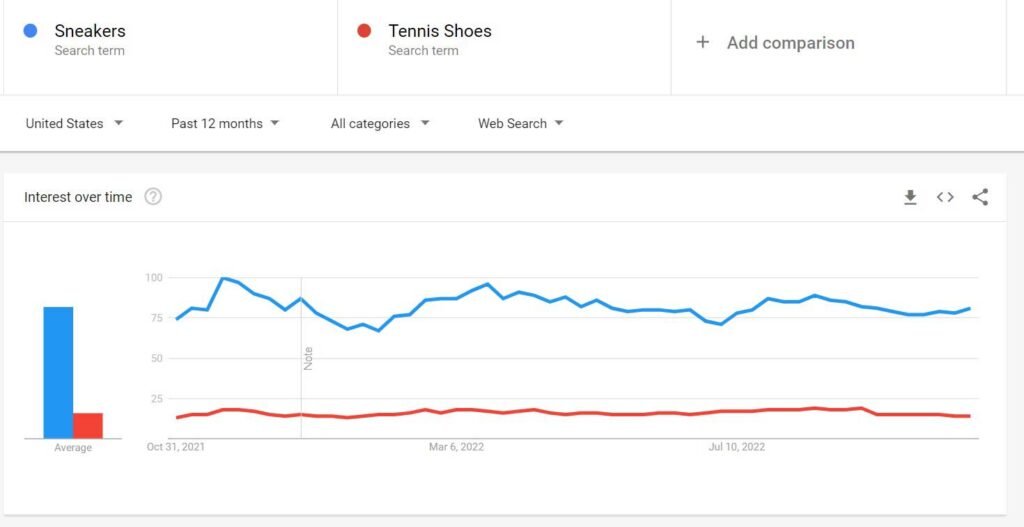
There’s a clear regional difference between “sneakers” and tennis shoes in the U.S. as a whole, although it fails to recognize the regional differences between the two phrases. It’s also mapped, thankfully.
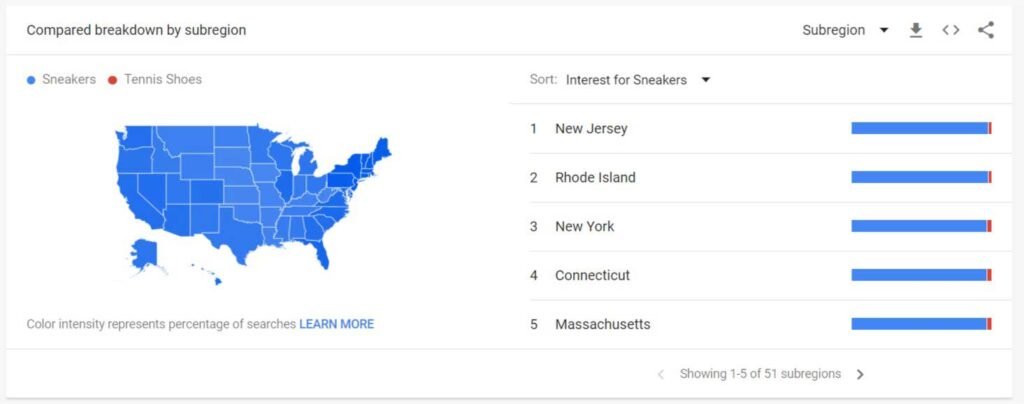
Sneakers vs Running Shoes
You might find yourself involved in another argument once you learn the difference between sneakers and tennis shoes: sneakers vs. running shoes. As I always say, don’t worry; I have all the answers to your questions!
Running and walking are the most common uses for sneakers. Sneakers can be used as running shoes as long as they provide cushioning, lightweight, and forward movement support.
The shoes are, unlike sneakers, also specifically designed for certain purposes, just as tennis shoes are. Shoes designed specifically for runners are known as running shoes.
Runners wear these shoes with a heel designed so that their feet do not have to impact the ground as hard while running. Their flexibility also protects your foot from strain when it arches while running, unlike their sneaker counterparts.
Can I Wear Sneakers to Play Tennis?
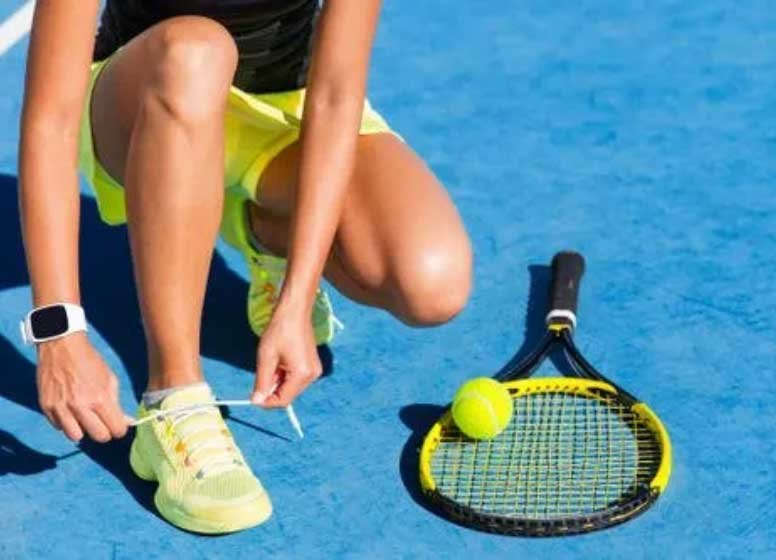
Tennis shoes are not the best choice if you want to look good while playing. There are tennis shoes designed specifically for a particular sport. Other shoes that are not designed with this criterion in mind will not be able to accomplish the task. It is not appropriate to use sneakers for that purpose.
You may enjoy reading What Tennis Shoes Does Djokovic Wear?
Tennis Shoes vs Sneakers: Which Is Better?
It is important to determine the purpose of the shoes before deciding whether to purchase sneakers or tennis shoes. Sneakers are a better choice if you want to wear something every day or make a fashion statement.

Many of them can be budget-friendly, and there is a great variety of them to choose from. While you might want to save up your money for some good sneakers if you are a casual tennis player playing recreationally, you might still look for some good sneakers that are comfortable.
Alternatively, if you’re a professional, investing in tennis shoes would be a good idea. When your feet are well supported, you will be more confident on the field, which will improve your performance.
If you want to choose tennis shoes that are appropriate for your court, consider the type of court you are going to play on. I can tell you from experience that it will make a difference.
It all depends on what you prefer, as I always say. Tennis shoes are great for walking or wearing for work, and sneakers are great for playing tennis. No matter what purpose they serve, the most important thing is that they make you feel confident and comfortable!
Faqs
Are sneakers and tennis shoes the same thing?
Sneakers are just simple shoes with rubber soles and canvas tops designed for casual wear. Tennis shoes are technically designed to be worn during tennis matches. Sneakers may be worn outside the court instead of tennis shoes, but tennis shoes cannot be worn inside the court.
What makes a sneaker a tennis shoe?
The soles of tennis shoes are typically designed with patterns that are tailored to the surface of the court you usually play on. In other types of shoes, the heels are thicker and softer, which can reduce weight, cushioning, and impact while tennis shoes are built to be more sturdy.
Where do they call sneakers tennis shoes?
Runners and running shoes refer to sneakers in Hiberno-English, Canadian, and Australian English. In Australian and North American English, tennis shoes are also referred to as tennis shoes.
Can I wear tennis shoes for walking?
Yes, sneakers make excellent walking shoes.
Final Thoughts
Even though all athletic shoes originate from the same place, they have evolved over the years to be particularly designed for sports players, like tennis players.
Here is a recap of the differences between tennis shoes and sneakers:
- Despite the fact that people use the terms interchangeably, sneaker and tennis shoes are not the same.
- In general, sneakers are comfort and/or style shoes that are intended for everyday use, as well as for athletic pursuits.
- Tennis shoes are specifically designed to assist tennis players. Since they are made of a material that absorbs shock, they support the legs and feet of the players.
- Among the six differences between sneakers and tennis shoes are the purpose, the material, the support, the durability, the cushioning, and the availability.
- A running shoe also differs from a casual shoe because it is designed specifically for runners because of its heel structure and flexibility.
- The most important thing is to wear whatever makes you feel comfortable and confident when you choose a pair of sneakers or tennis shoes.
Tennis sneakers are definitely possible to use, but they won’t provide the same level of traction, support, or comfort when played on courts.




Comments are closed.